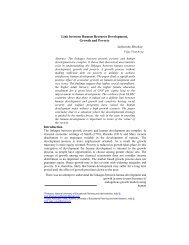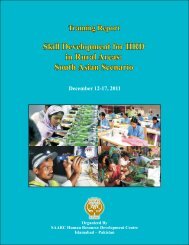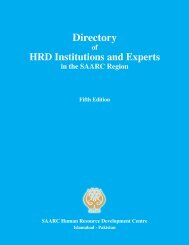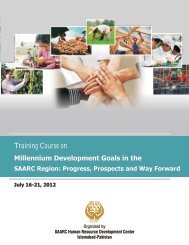Here - SAARC Human Resource Development Centre
Here - SAARC Human Resource Development Centre
Here - SAARC Human Resource Development Centre
- No tags were found...
You also want an ePaper? Increase the reach of your titles
YUMPU automatically turns print PDFs into web optimized ePapers that Google loves.
Working Sessionsiii) Use of ICT for Improving Education and Governanceiv) Effective Communication for Sustainable Social <strong>Development</strong>Summary:Shri Ajay Sawhney discussed the National e-Governance Plan (NeGP) vision ofIndia. He stated that it is to make all government services accessible to the commonman in his locality, through common service delivery outlets and ensure efficiency,transparency and reliability of such services at affordable cost. In the NeGP servicedelivery strategy, it was told that a common digital service delivery infrastructureconsisting of State Wide Area Network (SWAN), State Data <strong>Centre</strong> (SDC),National/State Service Delivery Gateway (NSDG), (SSDG), State Portal andCommon Services <strong>Centre</strong> (CSC) is being created in every state and Union Territoryto ensure seamless and single window delivery of public service to the masses. Tobring the benefit of ICT at the last mile and ensure transparent, timely and hassle freedelivery of citizen service, Government of India has approved NeGP comprising of27 Mission Mode Projects (MMPs). Status of various MMPs was also discussedduring the presentation. He discussed the case study of Gujarat State in training andcapacity building to adopt and utilize e-governance. It was told that India's e-governance approach is that e-government is not about technology but is concernedwith the transformation of people and processes, adoption of the best managementprinciples and establishing appropriate partnership to ensure sustainability and costeffectiveness. Department of IT, Government of India has taken responsibility ofintroducing e-governance across the departments and the country in a phasedmanner as a part of NeGP. Given the diversity of the country with respect to its e-readiness and experience in implementing projects of such nature, there aresignificant differences in capacities of States/UTs, to undertake such initiatives. It isin this background that Department of IT, Government of India has adoptedstrategies that involve capacity building to achieve goals of NeGPProf. Mangal Sunder K. in his presentation discussed the ways to address digitalbarriers causing digital divide in the <strong>SAARC</strong> region and Indian Experience inHigher Education Sector. He stated several issues in bridging the gap betweendigital divides and removing barriers that include: i) building educational networksreflecting the strength of each country and complementing that of the others andsharing academic resources; ii) sharing good network practices and establishing9
















